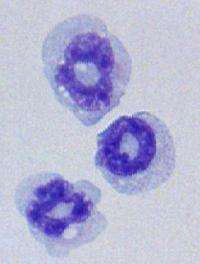Scientists discover new type of cell with a key role in treatment-resistant asthma

For most people with asthma, a couple of puffs from an inhaler filled with steroids makes breathing easy. But if their lungs become resistant to the calming effect of that medicine, they live in fear of severe asthma attacks that could send them to the hospital – or worse.
Now, new research from the University of Michigan Health System may help explain what's going on in the lungs of these steroid-resistant individuals. The findings could aid the development of new treatment options, and of better ways to identify people at risk of becoming steroid-resistant.
The U-M scientists have discovered a new type of cell in mice that appears to be crucial to causing asthma symptoms -- even in the presence of steroid. The research, published in Nature Medicine, also showed that people with asthma have a very similar cell type in their blood at higher levels than people without the condition.
The researchers call the new cell type T2M, for type 2 myeloid – reflecting its origin in the bone marrow and its involvement in the "type 2" immune response that causes asthma symptoms. In the lungs, T2M cells were shown to receive specific distress signals sent out by cells in the lung lining – and to produce molecules that lead to more inflammation.
The role of these cells was uncovered after a persistent search by a team led by pathology professor Nicholas Lukacs, Ph.D., and Bryan Petersen, a student in U-M Medical School's Medical Scientist Training Program who recently completed a Ph.D. thesis based on these findings.
They found the cells while examining the role of a signaling molecule called interleukin 25, or IL-25 -- a type of protein called a cytokine that other asthma-probing scientists and pharmaceutical companies are also looking closely at.
The U-M team searched for cells that had a receptor on their surface capable of receiving IL-25's inflammation-promoting signal, and isolated a type of granulocyte that hadn't been observed before. They found that when these cells received IL-25 signals, they pumped out more inflammation-promoting cytokines called IL-4 and IL-13 that drive hallmarks of asthma such as mucus formation.
What's more, the cells could still do this in the presence of a steroid medication. And, the researchers showed they could essentially give steroid-resistant asthma to an animal that didn't have it or IL-25 receptors, by transferring the cells to their lungs.
They then partnered with U-M asthma and allergy specialist Alan Baptist, M.D., an assistant professor of internal medicine, to see if T2M-like cells could be found in humans.
They recruited volunteers both with and without asthma, and drew small amounts of blood from their arms. Sure enough, cells of a very similar type as that found in mice, with very similar proteins on their cell surface, showed up in higher amounts in the blood of the asthma sufferers.
Despite these results, Lukacs cautioned, "It's still too early to say that we could target these cells in humans. But because of the industry interest in IL-25 and its receptors, these results give that line of inquiry more fuel." Lukacs is also assistant dean for research at the U-M Medical School.
Petersen, who is also earning a medical degree as well as the doctorate he recently defended, notes that more research volunteers will be needed to explore the cells' role in humans. He, Lukacs and Baptist hope to open a new clinical trial soon that would allow both people with asthma – and those without – to aid the research.
"While we've verified that this cell can be seen in people with asthma, we need to find out in a large group if it is more prominent in people with more severe, treatment-resistant forms of the disease – and even whether it could help define the characteristics of someone who will eventually develop that form of asthma," he says.
Meanwhile, the researchers will continue exploring IL-25's role, and the way different irritants cause the cells in the lung lining to release it. For instance, viruses that infect the lungs can cause the release of IL-25 – and such infections are also a known cause of asthma attacks.
More information: Nature Medicine, Vol. 18, No. 5, May 2012. doi:10.1038/nm.2735















